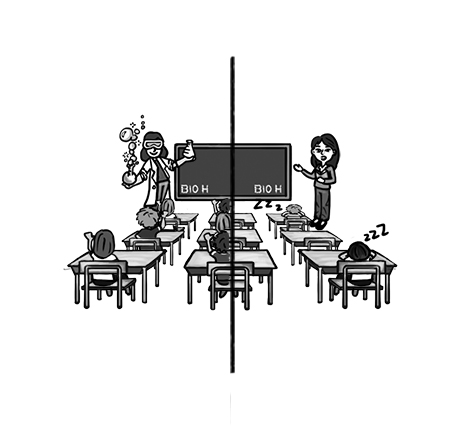While my friends were investigating a crime scene to diagnose fictional character Anna Garcia, I was one of the students taking “hard bio.”
As a freshman taking Biology Honors last year, I experienced course misalignment — when activities and assessments do not match among classes of the same course — starting from my first week of high school. Unlike mine, most Biology H classes at Palo Alto High School use a curriculum designed by nonprofit “Project Lead The Way,” which promotes a more project-based and hands-on learning approach, including cracking the mystery of Garcia’s illness.
My class was one of the few that generally stuck with the standard textbook. While its rigorous agenda was overwhelming for many, mainly due to the heavier homework load and difficult tests, I soon adjusted and even developed a keen interest in the subject.
When the nerve-wracking SAT Biology subject test rolled around at the end of the school year, students in PLTW felt even less prepared than anxious students in “hard” bio. For the first time, I witnessed friends complaining about their relatively easygoing class, about not moving at a faster pace or learning things necessary for the subject test.
Though teachers for the same course should have flexibility when it comes to designing and running their classes, this should not be achieved through diverging curricula because it is unfair to most of their students.
But misalignment did not just occur in science. For example, in English, I felt confused by the drastic variations between classes — some were heavy on vocabulary quizzes, while others revolved around fishbowl discussions. Personally, I’m more of an auditory learner, so classroom discussions help me most; however, not all learners share this preference, and others will also face impacts of misalignment from year to year.
Because liberal arts classes are usually more subjective, they are more difficult to align. According to English teacher George Vuong, the department tries to align major assignments and assessments, but prefers teachers to set their own ways of reaching those skill sets.
History and Social Justice Pathway teacher Caitlin Evans says course misalignment can sometimes elevate the classroom experience.
For example, in Contemporary World History, teachers share the same main course question but conduct different case studies within regions based on their respective specialties.
“Part of the reason we [the History Department] are misaligned is that we have the things that we’re really passionate about,” Evans says. “People like to make everything super fair; I don’t think that’s always the best fit. It doesn’t serve as many kids as possible.”
Although I recognize the benefits of teachers using their curriculum as an outlet for their passions and more creativity when it comes to the opportunity for designing their curricula, it seems unfair to students.
Students should not be worrying over a “hard” or “easy” or “confusing” curriculum.
On the other hand, departments like math are usually strictly aligned. Students usually follow a calendar with almost identical homework assignments and test schedules. The tests that are distributed among classes are essentially the same, and score averages seem to be relatively similar. Though some students may still be dissatisfied, at least they are all given equal opportunities. Math teachers seem to incorporate their own personalities when it comes to teaching, yet I have noticed fewer complaints about classes being misaligned.
This comes down to the question of whether students should willingly adapt to the idea of going through different experiences in classes compared to their peers, or that they should rather have classes run similarly — as they do in math — which gives students a more equal experience though the classes still do not tailor to every students’ needs.
I propose that we lean closer to the math model as a step toward the goal of course alignment. Teachers should avoid teaching in a way that results in students receiving different material than their peers, and perhaps if they did, students would not feel the need to label classes in the same course as more “laid-back” or more “difficult.” Ultimately, aligning courses will ensure a more even-handed experience for students taking the same courses but are in different classes.



